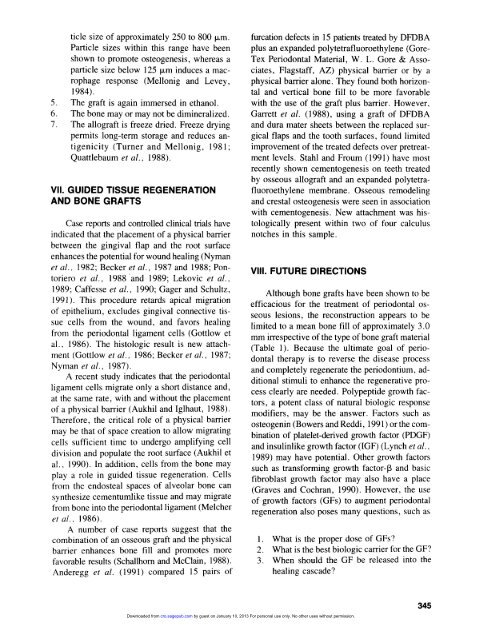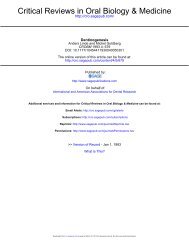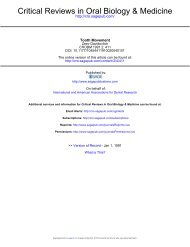Autogenous and Allogeneic Bone Grafts in Periodontal Therapy
Autogenous and Allogeneic Bone Grafts in Periodontal Therapy
Autogenous and Allogeneic Bone Grafts in Periodontal Therapy
Create successful ePaper yourself
Turn your PDF publications into a flip-book with our unique Google optimized e-Paper software.
tide size of approximately 250 to 800<br />
Particle sizes with<strong>in</strong> this range have been<br />
shown to promote osteogenesis, whereas a<br />
particle size below 125 |xm <strong>in</strong>duces a macrophage<br />
response (Mellonig <strong>and</strong> Levey,<br />
1984).<br />
5. The graft is aga<strong>in</strong> immersed <strong>in</strong> ethanol.<br />
6. The bone may or may not be dim<strong>in</strong>eralized.<br />
7. The allograft is freeze dried. Freeze dry<strong>in</strong>g<br />
permits long-term storage <strong>and</strong> reduces antigenicity<br />
(Turner <strong>and</strong> Mellonig, 1981;<br />
Quattlebaum et al, 1988).<br />
VII. GUIDED TISSUE REGENERATION<br />
AND BONE GRAFTS<br />
Case reports <strong>and</strong> controlled cl<strong>in</strong>ical trials have<br />
<strong>in</strong>dicated that the placement of a physical barrier<br />
between the g<strong>in</strong>gival flap <strong>and</strong> the root surface<br />
enhances the potential for wound heal<strong>in</strong>g (Nyman<br />
et al, 1982; Becker et al, 1987 <strong>and</strong> 1988; Pontoriero<br />
et al, 1988 <strong>and</strong> 1989; Lekovic et al,<br />
1989; Caffesse et al, 1990; Gager <strong>and</strong> Schultz,<br />
1991). This procedure retards apical migration<br />
of epithelium, excludes g<strong>in</strong>gival connective tissue<br />
cells from the wound, <strong>and</strong> favors heal<strong>in</strong>g<br />
from the periodontal ligament cells (Gottlow et<br />
al., 1986). The histologic result is new attachment<br />
(Gottlow et al, 1986; Becker et al, 1987;<br />
Nyman et al, 1987).<br />
A recent study <strong>in</strong>dicates that the periodontal<br />
ligament cells migrate only a short distance <strong>and</strong>,<br />
at the same rate, with <strong>and</strong> without the placement<br />
of a physical barrier (Aukhil <strong>and</strong> Iglhaut, 1988).<br />
Therefore, the critical role of a physical barrier<br />
may be that of space creation to allow migrat<strong>in</strong>g<br />
cells sufficient time to undergo amplify<strong>in</strong>g cell<br />
division <strong>and</strong> populate the root surface (Aukhil et<br />
al., 1990). In addition, cells from the bone may<br />
play a role <strong>in</strong> guided tissue regeneration. Cells<br />
from the endosteal spaces of alveolar bone can<br />
synthesize cementumlike tissue <strong>and</strong> may migrate<br />
from bone <strong>in</strong>to the periodontal ligament (Melcher<br />
etal, 1986).<br />
A number of case reports suggest that the<br />
comb<strong>in</strong>ation of an osseous graft <strong>and</strong> the physical<br />
barrier enhances bone fill <strong>and</strong> promotes more<br />
favorable results (Schallhorn <strong>and</strong> McCla<strong>in</strong>, 1988).<br />
Anderegg et al (1991) compared 15 pairs of<br />
furcation defects <strong>in</strong> 15 patients treated by DFDBA<br />
plus an exp<strong>and</strong>ed polytetrafluoroethylene (Gore-<br />
Tex <strong>Periodontal</strong> Material, W. L. Gore & Associates,<br />
Flagstaff, AZ) physical barrier or by a<br />
physical barrier alone. They found both horizontal<br />
<strong>and</strong> vertical bone fill to be more favorable<br />
with the use of the graft plus barrier. However,<br />
Garrett et al. (1988), us<strong>in</strong>g a graft of DFDBA<br />
<strong>and</strong> dura mater sheets between the replaced surgical<br />
flaps <strong>and</strong> the tooth surfaces, found limited<br />
improvement of the treated defects over pretreatment<br />
levels. Stahl <strong>and</strong> Froum (1991) have most<br />
recently shown cementogenesis on teeth treated<br />
by osseous allograft <strong>and</strong> an exp<strong>and</strong>ed polytetrafluoroethylene<br />
membrane. Osseous remodel<strong>in</strong>g<br />
<strong>and</strong> crestal osteogenesis were seen <strong>in</strong> association<br />
with cementogenesis. New attachment was histologically<br />
present with<strong>in</strong> two of four calculus<br />
notches <strong>in</strong> this sample.<br />
VIII. FUTURE DIRECTIONS<br />
Although bone grafts have been shown to be<br />
efficacious for the treatment of periodontal osseous<br />
lesions, the reconstruction appears to be<br />
limited to a mean bone fill of approximately 3.0<br />
mm irrespective of the type of bone graft material<br />
(Table 1). Because the ultimate goal of periodontal<br />
therapy is to reverse the disease process<br />
<strong>and</strong> completely regenerate the periodontium, additional<br />
stimuli to enhance the regenerative process<br />
clearly are needed. Polypeptide growth factors,<br />
a potent class of natural biologic response<br />
modifiers, may be the answer. Factors such as<br />
osteogen<strong>in</strong> (Bowers <strong>and</strong> Reddi, 1991) or the comb<strong>in</strong>ation<br />
of platelet-derived growth factor (PDGF)<br />
<strong>and</strong> <strong>in</strong>sul<strong>in</strong>like growth factor (IGF) (Lynch et al,<br />
1989) may have potential. Other growth factors<br />
such as transform<strong>in</strong>g growth factor- (3 <strong>and</strong> basic<br />
fibroblast growth factor may also have a place<br />
(Graves <strong>and</strong> Cochran, 1990). However, the use<br />
of growth factors (GFs) to augment periodontal<br />
regeneration also poses many questions, such as<br />
1. What is the proper dose of GFs?<br />
2. What is the best biologic carrier for the GF?<br />
3. When should the GF be released <strong>in</strong>to the<br />
heal<strong>in</strong>g cascade?<br />
Downloaded from<br />
cro.sagepub.com by guest on January 10, 2013 For personal use only. No other uses without permission.<br />
345




